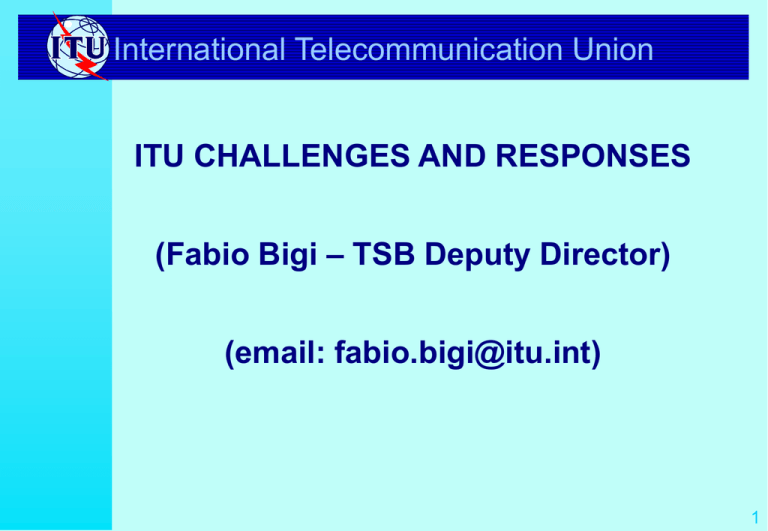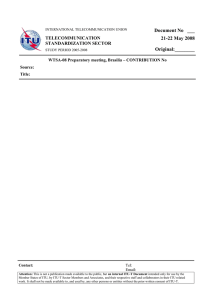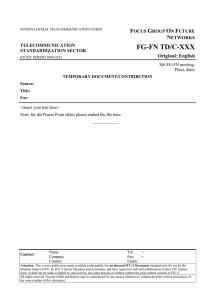International Telecommunication Union ITU CHALLENGES AND RESPONSES – TSB Deputy Director) (Fabio Bigi
advertisement

International Telecommunication Union ITU CHALLENGES AND RESPONSES (Fabio Bigi – TSB Deputy Director) (email: fabio.bigi@itu.int) 1 The current structure of ITU-T Study Groups SG 2 - Operational aspects of service provision, networks and performance SG 3 - Tariff and accounting principles including related telecommunications economic and policy issues SG 4 - Telecommunication management, including TMN SG 5 - Protection against electromagnetic environment effects SG 6 - Outside plant SG 9 - Integrated broadband cable networks and television and sound transmission SG 11 - Signalling requirements and protocols SG 12 - End-to-end transmission performance of networks and terminals SG 13 - Multi-protocol and IP-based networks and their internetworking SG 15 - Optical and other transport networks SG 16 - Multimedia services, systems and terminals SG17 - Data networks and software for Telecommunication SSG TSAG - Telecommunication Standardization Advisory Group - Special Study Group "IMT-2000 and beyond" 2 Lead Study Groups in specific areas of study SG 2 - Lead Study Group for service definition, numbering and routing SG 4 - Lead Study Group on TMN SG 9 - Lead Study Group on frame relay and for communication system security SG 11 - Lead Study Group on intelligent networks SG 12 - Lead Study Group on Quality of Service and performance SG 13 - Lead Study Group on IP related matters, B-ISDN, Global Information Infrastructure and satellite matters SG 15 - Lead Study Group on access network transport Lead Study Group on optical technology SG 16 - Lead Study Group on multimedia services, systems and terminals Lead Study Group on e-business and e-commerce SG17 - Lead Study Group on frame relay and for communication system security Lead Study Group on languages and description techniques SSG - Lead Study Group on IMT 2000 and beyond and for mobility 3 Special Projects IMT-2000 Network Aspects (SSG) Call Back (SG 3) Accounting Rate Reform (SG 3) TMN (SG 4) IP Cablecom (SG 9) Quality of service and performance (SG 12) IP (SG 13) GII (SG 13) Access Networks (SG 15) Optical Networks (SG 15) Mediacom 2004 (SG 16) E-commerce and E-business (SG 16) 4 Standardization Requirements Architecture Access Networks Transport Networks Terminals Services Coding Numbering Mobility QoS and Network Performance Interworking and Interoperability Market Oriented 5 Approval time for ITU-T Recommendations -1988 1989-1993 1993-1996 1997-2000 2000 - 4 years 2 years 18 months 9 months (5 months in exceptional circumstances) Minimum 4 weeks (AAP) 9 months (TAP) AAP = Alternative Approval Procedure TAP = Traditional Approval Procedure 6 Migration to IP-based networks 7 Draft ITU-T Strategic Plan for 2003-2006 Mission Facilitate the identification of areas where recommendations (standards) should be developed for the Information Society Efficiently develop high-quality, global, consensus-based recommendations (standards) in its core competency areas on a market-driven and timely basis Facilitate the interoperability of networks and services 8 Draft ITU-T Strategic Plan for 2003-2006 Mission - continued Be able to develop recommendations that may have regulatory or policy implications Be flexible and constantly look for ways to improve Give appropriate consideration to the particular needs of developing countries Cooperate and, where appropriate, collaborate with others so as not to duplicate effort 9 Draft ITU-T Strategic Plan for 2003-2006 Strategies/Processes bottom-up mode of operating and production of work (rather than top-down), flexibility in responding to market demands, ongoing review of the Strategic Plan, proposing adjustments as needed, through TSAG, monitoring the performance of the Sector against identified milestones, 10 Draft ITU-T Strategic Plan for 2003-2006 Strategies/Processes - continued development and strengthening of the linkage among financial, strategic, and operational planning, clear and transparent working methods and processes, to encourage transparency, inclusiveness, and representation of a broad range of participants and views, an environment in which interested parties can work together in partnership effectively and efficiently, development and execution of an aggressive plan to communicate the value of the ITU-T, stressing its global recognition and credibility and the high quality of its Recommendations, as well as its willingness to change, 11 Draft ITU-T Strategic Plan for 2003-2006 Strategies/Processes - continued working with ITU-D with special attention to telecommunication development in developing countries, including supporting ITU-D’s efforts to improve access to the Information Society in developing countries, offering an organization that is attractive to industry entities as a place to do their standardization development work, and willingness to change. 12 Draft ITU-T Strategic Plan for 2003-2006 Relationship with other standardization bodies foster awareness within ITU-T of the work done by other bodies (such as SDOs, forums and consortia), coordinate and cooperate with such groups in order to reduce duplication, avoid inconsistencies, and assure that ITU-T work provides added value, continue to participate in appropriate coordinating bodies, coordinate and cooperate with the Radiocommunication and Telecommunication Development Sectors, and with the General Secretariat and officials of the Union. 13 Possible Items for Consideration IP-based networks and their interconnection with telecommunication networks; IP cablecom project; establishment of GII; IMT-2000 and mobility; e-business and e-commerce; reform of accounting rates and tariff studies; MEDIACOM-2004 project and related multimedia activities; security aspects of networks and services; optical transport network; access networks enhancements with xDSL techniques; numbering and routing; network performances and quality of services; protocols for new services and intelligent networks. 14 GII: Center of Technology convergence (based on Figure 5-1/Y.110) TODAY Computer Information Telecommunication GII Consumer Entertainment NEAR FUTURE Computer Information Telecommunication GII Consumer Entertainment Computer Information 21st Century Telecommunication GII Consumer Entertainment 15 Standards in the future Areas Regulated Areas Intermediate Areas Competitive Areas Mandatory/Voluntary Mandatory Mandatory or Voluntary Voluntary Manager/Controller States/Governments -Frequency Allocation -GEOS Orbits Assignment Example -Numbering/Addressing Standards -Charging -Interconnection Rules States/Government or Private Sectors -IMT-2000(Global Roaming) -Call Back -Global Services e.g. IP Telephony Number Private Sectors -ATM -ISDN -SDH -IN -Multimedia -Internet -Other New Technologies ITU Role Predominant Player over many years One Player among many 16 Conclusion ITU Reform New Standardization Requirements Consensus standard (Regulators, Operators, Industry, Users) Membership requirements End user requirements 17


